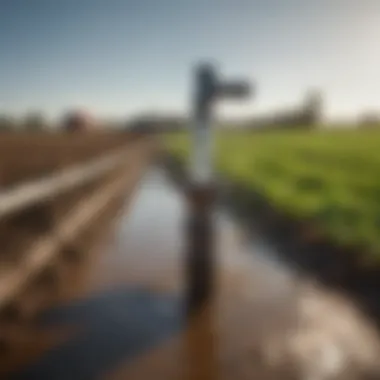Calculating Water Flow Through a Pipe: A Comprehensive Guide


Intro
Water is a vital resource in agriculture, playing a critical role in crop production and sustainability. Understanding the dynamics of water flow through pipelines is essential for effective irrigation management. This article delves into the principles, calculations, and considerations necessary for determining water flow in farming practices. By mastering these concepts, farmers and agronomists can enhance water efficiency, optimize crop yields, and minimize waste.
Topic Overview
Definition and Importance
Calculating water flow through a pipe refers to the determination of the volume of water that passes through a specified cross-section of a pipe over a given period. This measurement is crucial for 여러 reasons:
- Ensuring adequate water supply for crops
- Designing effective irrigation systems
- Preventing water wastage
- Analyzing system efficiency
Understanding flow rate impacts both short-term watering schedules and long-term resource management for farms.
Brief History and Evolution
The study of fluid dynamics can be traced back to ancient civilizations. Early hydraulic engineering focused on simple concepts of flow and pressure. Over centuries, the evolution of this field has integrated sophisticated mathematics and physics. Modern technology has introduced advanced sensors and software, enabling real-time monitoring and calculation of water flow, making it essential for contemporary agricultural practices.
Key Techniques and Innovations
Sustainable Farming Practices
Sustainable agriculture emphasizes responsible water usage. Farmers are increasingly adopting techniques that optimize flow and minimize consumption. Some noteworthy practices include:
- Drip irrigation: Delivers water directly to the plant roots, reducing evaporation and runoff.
- Rainwater harvesting: Collecting and storing rainwater for irrigation purposes.
These techniques not only conserve water but also improve crop quality and yields.
Advanced Agronomic Technologies
Innovations in technology have transformed irrigation practices. Smart irrigation systems utilize data analytics to adjust flow rates based on real-time conditions. Some critical advancements include:
- Soil moisture sensors: Measure moisture levels to determine watering needs.
- Automated irrigation controllers: Optimize water delivery schedules based on weather patterns.
These technologies enhance efficiency and reduce labor costs.
Practical Applications
Step-by-Step Guides
Calculating water flow through a pipe involves several steps:
- Determine the pipe diameter: Measure the internal diameter using a caliper.
- Calculate the cross-sectional area: Use the formula A = π(d/2)².
- Estimate the flow rate: Apply Bernoulli's principle to determine pressure differences.
- Apply flow equations: Use the Q = A v equation, where Q is the flow rate, A is the cross-sectional area, and v is the velocity.
Case Studies or Real-World Examples
In a practical example, consider a farm utilizing a drip irrigation system with a pipe diameter of inches. After measuring, the internal diameter is found to be 1. inches. The farmer calculates the cross-sectional area and uses it to ascertain a flow rate that meets the crop's needs. This targeted approach highlights the operational benefits of precise calculations in real-world agricultural settings.
"Accurate water flow calculations enable farmers to make informed decisions on irrigation strategy, directly impacting yield and sustainability."
Prelims to Water Flow in Pipes
Understanding water flow through pipes is essential in various fields, particularly agriculture. Water is a critical resource, and knowing how to manage its movement can enhance productivity and sustainability in farming. When farmers and agronomists comprehend the flow dynamics, they can optimize irrigation systems to ensure crops receive the right amount of water.
Significance of Water Flow Calculations
Calculating water flow accurately is vital for several reasons. First, it helps in determining the proper size of pipes and pumps needed for irrigation tasks. If the water flow is too low, crops may not receive adequate moisture. Conversely, excessive flow can lead to erosion or water wastage. Secondly, these calculations contribute to cost-effectiveness. Efficient water usage can lead to lower utility bills and better resource management. Moreover, understanding how water flows through different materials can inform decisions on infrastructure investments, like whether to use PVC or metal pipes in specific applications.
Overview of Fluid Dynamics


Fluid dynamics is a branch of physics dealing with the behavior of liquids and gases. It plays a crucial role in understanding how fluids move through pipes. Key concepts within fluid dynamics include pressure, velocity, and flow rate. An increase in velocity, for example, generally corresponds to a drop in pressure within the flow system. This relationship impacts how water dispenses in agricultural settings.
Through fluid dynamics, farmers can learn about laminar and turbulent flows. Laminar flow is smooth and occurs at lower velocities, while turbulent flow is chaotic and found at higher velocities. Understanding these concepts can support better design choices in irrigation systems, leading to improved outcomes.
Key point: A solid grasp of fluid dynamics not only promotes efficiency but also enhances the sustainability of agricultural practices.
Theoretical Principles
The theoretical principles behind water flow are fundamental to understanding how liquids behave in pipes. These principles provide a framework for calculating flow rates and help assess the effectiveness of different pipe configurations. This section discusses several key equations and concepts that form the basis of fluid dynamics, accentuating their significance in practical applications.
Bernoulli's Equation
Bernoulli's Equation is a pivotal formula in fluid dynamics. It describes the conservation of energy in flowing fluids. At its core, it states that an increase in the speed of a fluid occurs simultaneously with a decrease in its potential energy. This equation is articulated as:
[ P + \frac12 \rho v^2 + \rho gh = constant ]\
Where:
- ( P ) is the pressure within the fluid,
- ( \rho ) represents the fluid density,
- ( v ) is the fluid velocity, and
- ( g ) is the gravitational acceleration.
The formula illustrates that for a fluid flowing in a pipe, changes in height and speed will affect pressure. For irrigation systems, understanding how pressure fluctuates in different sections of the pipe can inform decisions about system design and fluid distribution.
Continuity Equation
The Continuity Equation is essential for ensuring the conservation of mass in fluid systems. It posits that the mass flow rate must remain constant from one cross-section of a pipe to another. In simpler terms, if the cross-sectional area of a pipe changes, the speed of the fluid must adjust accordingly to maintain flow. The equation is expressed as:
[ A_1 v_1 = A_2 v_2 ]\
Where:
- ( A_1 ) and ( A_2 ) are the cross-sectional areas at two points in the pipe,
- ( v_1 ) and ( v_2 ) are the respective velocities.
This relationship is particularly relevant when dealing with changes in pipe diameter. In agricultural applications, using the continuity equation can optimize the design of an irrigation system by ensuring that water is delivered efficiently from the source to the fields.
Hydraulic Radius
Hydraulic Radius is a measure used to describe the efficiency of a pipe or channel in transporting fluid. It is defined as the ratio of the cross-sectional area of flow to the wetted perimeter. The equation is given by:
[ R_h = \fracAP ]\
Where:
- ( R_h ) is the hydraulic radius,
- ( A ) is the cross-sectional area of flow, and
- ( P ) is the wetted perimeter.
A larger hydraulic radius indicates a more efficient system. In the context of irrigation or water distribution, maximizing hydraulic radius can lead to improved flow rates, thereby facilitating better water management. Understanding these principles can empower farmers to make informed decisions in designing and operating their irrigation systems.
Key Factors Affecting Water Flow
Understanding the key factors affecting water flow is crucial for proper management in agricultural practices. This section outlines the fundamental elements that influence how water moves through pipes. Enhancing knowledge in these areas not only improves irrigation effectiveness but also promotes better resource management. The four primary factors include pipe diameter, pipe length, pipe material and texture, and the viscosity of the fluid. Each of these aspects is interconnected and impacts overall flow rate significantly.
Pipe Diameter
The diameter of a pipe is a significant factor influencing water flow. The flow rate increases with a larger diameter, as it allows more water to pass through at once. From a practical standpoint, understanding this can guide farmers when selecting pipe sizes for their irrigation systems.
On the other hand, too large of a diameter can lead to issues such as increased costs for materials and potentially wasted water in some cases. Therefore, calculating the appropriate pipe diameter involves considering the type of crop and water requirements.
Pipe Length
Pipe length also plays a vital role in flow rate. Longer pipes can contribute to greater friction losses, which reduce water pressure and flow over distance. This means that as water travels through a lengthy pipe, energy is lost due to friction against the pipe walls. Farmers should perform calculations to balance the need for long-distance water transport with the need to maintain adequate flow rates.
A common approach is to use shorter pipes whenever possible to minimize friction losses.


Pipe Material and Texture
The material and surface texture of a pipe can influence flow as well. Different materials like PVC, HDPE, and metal have distinct properties affecting friction and resistance. For example, smoother surfaces tend to reduce friction, promoting higher flow rates, while rough textures can hinder movement. Farmers must be aware of these factors when selecting pipes to ensure efficient water delivery systems.
Viscosity of the Fluid
Finally, the viscosity of the water itself is an important consideration. Viscosity refers to the thickness or resistance to flow in a liquid. Warmer water tends to have lower viscosity, allowing it to move more freely compared to cold water. In agricultural contexts, this can affect irrigation efficiency and the amount of water that reaches crops.
Calculating Flow Rate
Calculating flow rate is essential for anyone involved in managing water resources, especially in agriculture. Understanding how much water flows through a pipe assists in designing irrigation systems, ensuring crops receive sufficient water without wastage. By mastering flow rate calculations, farmers can optimize water usage and enhance crop production, contributing to sustainable farming practices. The emphasis on this topic in the guide guides users through core calculations, practical applications, and the need to consider various factors affecting flow.
Using Flow Rate Formulas
Q = A × v
The formula Q = A × v represents a fundamental relationship where Q is flow rate, A is the cross-sectional area of the pipe, and v is the fluid velocity. This equation underscores a critical aspect of fluid dynamics: that flow rate is directly proportional to both the area and the velocity of the water moving through the pipe.
Key characteristics of this formula include its simplicity and ease of use. Farmers appreciate it because it provides a straightforward calculation, enabling quick assessments of water distribution.
The unique feature here is that it allows for varied input values, meaning slight adjustments in either A or v can yield different outputs for Q. Thus, it is versatile for different pipe sizes or water speeds. However, while this formula is popular because of its accessibility, it assumes laminar flow conditions, which may not always be the case in larger systems.
Flow Through Orifices
Flow through orifices plays an important role in practical applications, particularly in designing irrigation systems and control mechanisms. This concept refers to the flow of fluid when passing through an opening, typically under the influence of gravity or pressure. The key characteristic is its relationship with pressure differentials; flow tends to increase with larger pressure differences.
This is beneficial when considering various methods to regulate flow rates effectively. Farmers often utilize this concept for drip irrigation or water management systems where precise control of water delivery is necessary.
One unique feature of flow through orifices is its dependability across different types of fluids and conditions, making it widely applicable. While it is an essential tool, one must also consider the potential for turbulence and energy loss in systems where high flow rates are present.
Impact of Pressure Loss
Pressure loss is an inevitable factor in any pipe system. It occurs due to friction between the fluid and the pipe walls, changes in elevation, or fittings in the system. Understanding pressure loss is essential for accurate flow rate calculations.
When water moves through a pipe, it encounters resistance that can significantly affect the flow rate. High pressure drop can lead to inefficient water delivery, which can impact crop productivity. As such, farmers need to factor in these losses when planning their irrigation setups.
Practical Applications in Agriculture
Understanding water flow through pipes is crucial in agriculture. This knowledge directly affects crop yield, resource management, and sustainability practices. Farmers and agronomists can utilize this understanding to optimize irrigation methods and enhance water conservation efforts. Precision in water flow calculations enables better planning of irrigation systems, leading to decreased wastage and improved economic returns.
Irrigation Systems Design
When designing irrigation systems, calculating water flow properly can determine the success of the entire farming operation. Different crops have varying water needs based on their growth stages and climatic conditions. For instance, certain plants may require more water during the hot summer months, while some may need less during cooler periods. A well-designed irrigation system accounts for these variables while ensuring even distribution of water.
Key considerations for effective irrigation systems design include:
- Water source reliability: Assessing available sources like ponds, rivers, or groundwater.
- Flow rate calculations: Using the right formulas to determine how much water is needed and when.
- System layout: Planning pipe layout for efficient water delivery directly to the roots of plants.
By implementing proper design techniques, farmers can achieve optimal crop production with minimal water waste. Well-calibrated irrigation systems ensure that each area receiving water meets the appropriate needs of the crops.
Water Resource Management
Water resource management plays a significant role in sustainable agriculture. Effective flow calculations help to allocate water resources wisely. By understanding the nuances of how water moves through different pipe systems, farmers can ensure that every drop is used efficiently. Mismanagement can lead to over-irrigation, under-irrigation, or even waterlogging, which can adversely affect crop health and soil structure.
Considerations for effective water resource management include:
- Monitoring usage: Continuously tracking water flow to adjust for any fluctuations in demand.
- Drought management strategies: Planning for dry spells by optimizing water storage or using drought-resistant crops.
- Soil moisture assessment: Regular evaluation of moisture levels in the soil can guide irrigation practices.
Farmers incorporating water resource management techniques tend to find balance between their crop needs and the sustainability of their water resources. This not only improves the resilience of agricultural practices but also supports environmental health.
"Effective water management is not just about maximizing efficiency; it's about creating a sustainable future for agriculture."


By applying these principles in both irrigation design and water management, farmers enhance their ability to produce effectively while protecting vital resources. Learning and adapting flow calculation methods can lead to improved decision-making and better overall outcomes for agricultural practices.
Real-World Examples
Understanding real-world applications of water flow calculations is essential for several reasons. A practical context helps ground theoretical concepts, making them relevant for professionals in agriculture. Actual scenarios illuminate how theories like Bernoulli’s Equation and the Continuity Equation fold into everyday implementations. This section covers two key instances: drip irrigation systems and flow meter applications. These examples not only illustrate the calculations but also guide decision-making in water resource management.
Case Study: Drip Irrigation
Drip irrigation is a precise method that delivers water directly to the plant roots. This system minimizes evaporation and runoff, fundamentally improving water usage efficiency. The calculation of water flow through the pipes in such systems is critical to achieving optimal performance.
To design an effective drip system, one must consider several parameters like:
- Pipe diameter to ensure adequate pressure and flow.
- Emitter spacing, which determines how evenly water is distributed.
- Total length of the piping, impacting how pressure drops along the system.
Calculating flow rate in drip irrigation often involves the use of models that factor in emitter flow rates and the layout of the system. A balanced design enhances plant health and boosts agricultural sustainability.
"Effective water management is as critical as soil management for agricultural success."
Example: Flow Meter Usage
Flow meters are devices that measure the amount of water flowing through pipes. Their role is significant in both agricultural and industrial applications, helping monitor water usage and identify leaks or inefficiencies in water distribution systems.
Using flow meters provides several advantages:
- Accurate measurements of water flow rates ensure proper allocation in irrigation practices.
- Real-time data assists in decision-making, allowing for immediate adjustments to water usage.
- Leak detection helps conserve water, which is pivotal in areas facing scarcity.
The installation of a flow meter requires precise calculations. Understanding the specifics of the system, such as pressure and desired flow rate, is essential to choose the appropriate type of flow meter—be it electromagnetic, ultrasonic, or mechanical. This insight helps maintain a balance between effective irrigation practices and water conservation.
Challenges and Solutions
In the realm of calculating water flow through pipes, challenges are inevitable. These challenges can arise from a variety of factors that complicate accurate measurements. However, understanding these challenges and exploring innovative solutions is crucial for efficient water management, especially in agriculture. This section delves into common issues faced during flow calculations and highlights strategies for overcoming them.
Common Issues in Flow Calculations
Calculating water flow is often hindered by several common issues. Some of these issues include:
- Inaccurate Measurements: Errors may stem from using inappropriate or faulty equipment. For instance, improper calibration of flow meters can lead to misleading results.
- Changes in Fluid Properties: Variations in temperature or pressure can alter the viscosity of water, affecting flow rates. Accurate calculations require consistent monitoring of these conditions.
- Pipe Condition: The interior condition of pipes is vital. Corrosion, buildup, or wear can change the effective diameter and roughness, leading to deviations in flow calculations.
- Complex Geometries: Many agricultural systems include bends, fittings, or other components that can introduce turbulence and affect flow patterns. These elements must be factored into any calculations.
Understanding these potential pitfalls helps in preparing for accurate flow measurement and management. Awareness is the first step toward effective solutions.
Innovative Solutions
To tackle the challenges mentioned, various strategies can be employed to enhance accuracy and reliability in water flow calculations. Here are some effective solutions:
- Regular Maintenance and Calibration: Ensuring flow measuring instruments, like flow meters, undergo regular checks can prevent inaccuracies. Calibration according to standards yields reliable measurements.
- Advanced Measuring Techniques: Adoption of technologies such as ultrasonic flow meters can significantly reduce errors. These devices offer non-invasive methods for accurate flow measurement without disrupting the system.
- Hydraulic Modeling: Utilizing computational fluid dynamics (CFD) allows for simulations of water flow. This modeling can reveal how changes in pipe configuration will impact flow, informing future design decisions.
- Data Logging and Monitoring: Employing data loggers to continuously track flow conditions aids in understanding patterns and periods of fluctuation. This information can be crucial for adjusting management practices in real time.
By employing these solutions, agricultural managers can improve the accuracy of their water flow calculations.
"Accurate water flow calculations are essential for optimizing resource use and ensuring sustainability in agricultural practices."
The End and Future Perspectives
In the realm of water management, understanding how to accurately calculate water flow through pipes is paramount. This article synthesizes vital knowledge that can aid not only agricultural practices but also broader applications in different sectors. As water scarcity becomes an increasing concern, the significance of precise flow calculations cannot be overstated.
Effective water management hinges on the ability to measure and anticipate water flow accurately. Farmers can optimize irrigation systems, reduce waste, and ensure crops receive adequate hydration without superfluous overhead. Engaging with the principles outlined throughout this guide builds a foundation that can lead to more sustainable practices. Moreover, considering the challenges identified earlier, embracing innovative solutions will be critical for future advancements.
Summary of Key Takeaways
- Understanding basic principles of fluid dynamics is essential for accurate calculations.
- Factors such as pipe diameter, length, and material can significantly impact flow rates.
- Employing formulas like Bernoulli's Equation and the Continuity Equation can offer reliable results.
- Real-world applications, especially in agriculture, highlight the practical importance of these calculations.
- Constant improvement and adaptation to new technologies can enhance measurement accuracy.
Advancements in Water Flow Measurement
The future of water flow measurement looks promising with advancements in technology playing a crucial role. Emerging tools, such as smart flow meters, provide real-time data and analytics. These devices can track changes in flow and alert users to irregularities, promoting proactive management.
Furthermore, developments in digital modeling software enable users to predict flow patterns under varying conditions. With improved precision, agriculturalists can better plan irrigation schedules, which can lead to substantial cost savings. Improved sensors, coupled with integration into IoT systems, will enable farmers to manage resources more efficiently.
In summary, the evolution of measurement technology is set to transform how water flow is calculated and managed, supporting sustainable practices and enhancing productivity in agriculture. Keeping abreast of these changes will be essential for anyone involved in the agricultural sector.



